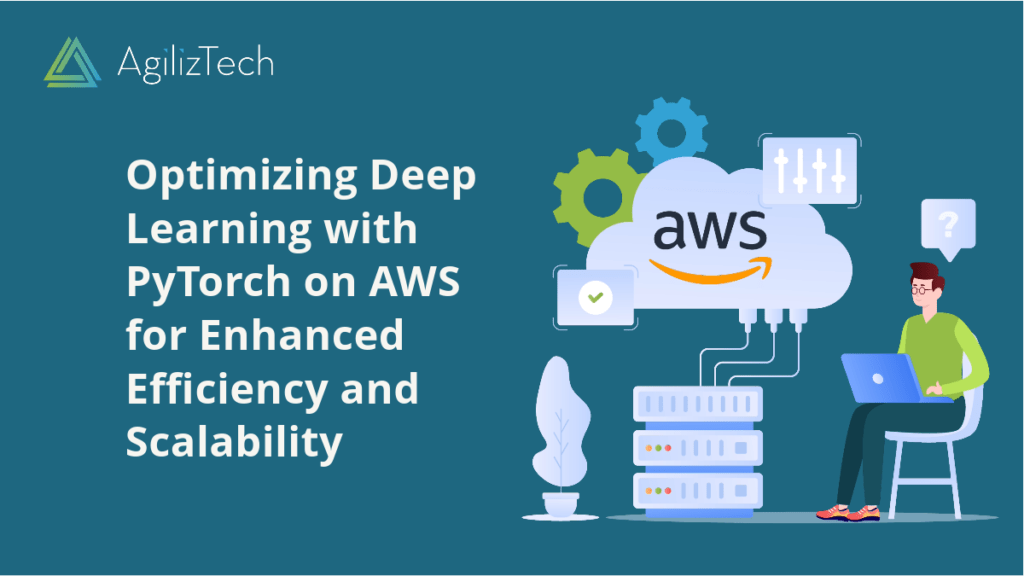
Streamlining Deep Learning with PyTorch on AWS
Introduction
Are you looking for a way to train and deploy your PyTorch models on the cloud? Do you want to leverage the power and scalability of AWS services for your deep learning projects? If yes, then this blog post is for you.
This post will explore using PyTorch on AWS, a highly performant, scalable, and enterprise ready PyTorch experience.
What PyTorch on AWS offers
PyTorch on AWS is an open-source deep learning framework that accelerates the process from ML research to model deployment. It offers the following features:
- AWS Deep Learning AMIs are Amazon Elastic Compute Cloud (EC2) instances preinstalled with PyTorch and other popular deep learning frameworks. They equip ML practitioners and researchers with the infrastructure and tools to accelerate deep learning in the cloud at scale. They also support Habana Gaudi–based Amazon EC2 DL1 instances and AWS Inferentia-powered Amazon EC2 Inf1 instances for faster and cheaper inference.
- AWS Deep Learning Containers are Docker images preinstalled with PyTorch and other popular deep learning frameworks. They make it easier to quickly deploy custom ML environments instead of building and optimizing them from scratch. They are available in the Amazon Elastic Container Registry (ECR) and can be used with Amazon Elastic Container Service (ECS), Amazon Elastic Kubernetes Service (EKS), or Amazon SageMaker.
- Amazon SageMaker is a fully managed service that provides everything you need to build, train, tune, debug, deploy, and monitor your PyTorch models. It also provides distributed libraries for large-model training using data or model parallelism. You can use Amazon SageMaker Python SDK with PyTorch estimators and models and SageMaker open-source PyTorch containers to simplify writing and running a PyTorch script.
What are the advantages of using PyTorch on AWS?
Using PyTorch on AWS has many benefits, such as:
- Performance: You can leverage the high-performance computing capabilities of AWS services to train and deploy your PyTorch models faster and more efficiently. You can also use AWS Inferentia, a custom chip designed to speed up inference workloads, to reduce your inference latency and cost by up to 71% compared to GPU-based instances.
- Scalability: You can scale your PyTorch models to handle large datasets and complex architectures using AWS services. You can use SageMaker distributed libraries to train large language models with billions of parameters using PyTorch Distributed Data Parallel (DDP) systems. You can also scale your inference workloads using SageMaker and EC2 Inf1 instances to meet your latency, throughput, and cost requirements.
- Flexibility: You can choose from various AWS services and options to suit your needs and preferences. You can use preconfigured or custom AMIs or containers, fully managed or self-managed ML services, CPU, GPU, or Inferentia instances. You can also use PyTorch multimodal libraries to build custom models for use cases such as real-time handwriting recognition.
- Ease of use: You can use familiar tools and frameworks to build your PyTorch models on AWS. You can use the intuitive and user-friendly PyTorch API, the SageMaker Python SDK, or the SageMaker Studio Lab, a no-setup, free development environment. You can also use SageMaker JumpStart to discover prebuilt ML solutions you can deploy with a few clicks.
How to use PyTorch on AWS for different use cases?
Once you have set up your PyTorch project on AWS, you can start building your models for different use cases. Here are some examples of how you can use PyTorch on AWS for various scenarios:
- Distributed training for large language models: You can use PyTorch DDP systems to train large language models with billions of parameters using SageMaker distributed libraries. You can also use EC2 DL1 instances powered by Habana Gaudi accelerators to speed up your training. For more details, see this case study on how AI21 Labs trained a 178-billion-parameter language model using PyTorch on AWS.
- Inference at scale: You can use SageMaker and EC2 Inf1 instances powered by AWS Inferentia to scale your inference workloads and reduce latency and cost. You can also use TorchServe, a PyTorch model serving framework, to deploy your models as RESTful endpoints. For more details, see this case study on how Amazon Ads used PyTorch, TorchServe, and AWS Inferentia to reduce inference costs by 71% and drive scale out.
- Multimodal ML models: You can use PyTorch multimodal libraries to build custom models that can handle multiple inputs and outputs, such as images, text, audio, or video. For example, you can use the PyTorch Captum library to create explainable AI models that can provide insights into how your model makes decisions. For more details, see this tutorial on how to use Captum to explain multimodal handwriting recognition models.
Conclusion
PyTorch on AWS is a great option for deep learning enthusiasts who want to take their PyTorch models to the next level. It offers performance, scalability, flexibility, and ease of use for various use cases. Whether a beginner or an expert, you can find the tools and services to build your PyTorch models on AWS.


